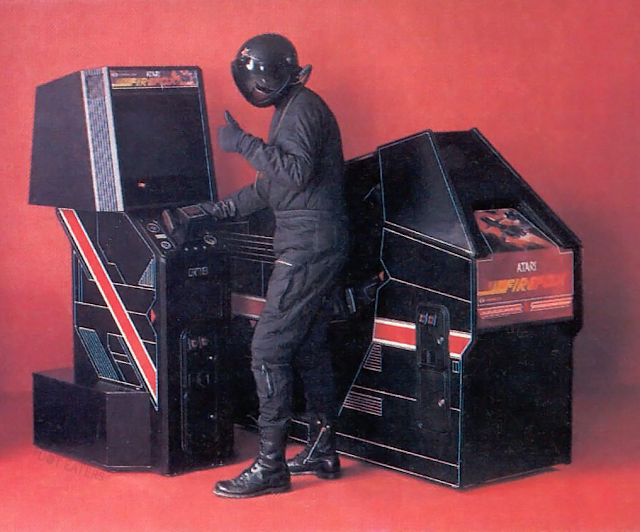Firefox Video and Arcade game
I’ve had a few photos and articles for this spin-off game on file now for a very long time, and thought it was about time to dig them out and post them here on the Archive for prosperity. I have to confess; I was never a ‘gamer’ myself and never really got into the whole gaming culture.
However, it seems that the Firefox game proved to be a rather popular one at the time. I’ve provided a bit of information on its history below plus a selection of photos, a magazine feature, and a part of an article that I found in my files - I’m not too sure what happened to the first half, but should I rediscover it I’ll edit and add it to this post.
Firefox was a 1984 shoot 'em up arcade video game based on the 1982 Clint Eastwood movie of the same name. It was produced in 1984 as Atari, Inc.'s only LaserDisc video game. Like Atari's first-person Star Wars and Empire Strikes Back, Firefox came as both an upright and sit-down cabinet with a yoke style controller.
Firefox was primarily designed by Mike Hally and Dave Ralston, and programmed by Greg Rivera and Norm Avellar. The cabinet featured stereo sound with an additional headphone port and volume control in the front. All Firefox cabinets shipped with a 19" Amplifone raster monitor, and utilized an Atari quad-POKEY. Firefox's power requirements necessitated the use of two Atari AR-II power supplies.
To collect the LaserDisc video, developers Mike Hally and Moe Shore sifted through 20 to 30 hours' worth of footage shot for the film. Most of the resulting footage was first-person shots filmed from helicopters flying over Greenland and Scandinavia. Firefox shares a cabinet with I, Robot, although significantly fewer I, Robot machines were produced.
In Japan, Game Machine listed Firefox on their April 1, 1984 issue as being the third most-successful upright/cockpit arcade unit of the month. In the United States, it was the top-grossing laserdisc game on the Play Meter arcade charts in July 1984.
www.atarihq.com stated: After many months of development Atari finally unleashed its first laserdisc game, Firefox, at the Amusement Showcase International in Chicago in the Spring of 1984. Atari released Firefox shortly thereafter, but it came at a time when there was a growing resistance to disc games in the marketplace from operators who had already sunk thousands of dollars in such games, and were still waiting to show a return on their investment.
Based, as you might imagine, on the 1983 adventure film of the same name starring Clint Eastwood, the game uses actual movie footage to simulate flying the famed Firefox fighter over treacherous ice fields, through billowing clouds, and in narrow crevasses. From the high-tech cabinet designs (both upright and cockpit) to its rousing original musical score; from the smooth disc operating system to its effective meld of filmed and computer-generated graphics, Atari had created one of the more technically impressive laser games of its time.
The game is operated by means of a two-handed Star Wars-type controller, equipped with cannon-firing trigger switches and missile-launching thumb buttons. What you control here is not the ship itself -- one presumes it's on automatic pilot -- but the on-screen cursor used to aim your weaponry. One nice feature here is that the cursor displays information regarding your fuel level and available missiles, eliminating the need to shift your eyes away from the action at any time. One bad feature is that at no time do you feel like you're actually in control of the Firefox ship.
Unfortunately, for all the technical wizardry Atari had demonstrated in creating Firefox, and for all the creativity the company had shown in adapting the movie storyline for video game use, all they're really come up with here is an elaborate target-shooting game. The early radar blasting stage of each part of the game is nothing more than an exercise in reaction -- as soon as a target pops up on the screen, you must shoot it immediately to avoid detection. Since this is the basic premise of the game, all a really skilled Firefox player will ever do is shoot at radar targets, which is certainly not the most exciting part of the contest.
The game is good looking, and offers some nice touches, such as Clint Eastwood's digitized voice, a variable game volume control, and other features. However, from a gameplay standpoint it's no better than average.
Below: Clint promotes the Firefox Arcade game













%20Magazine%20unknown.jpg)
No comments:
Post a Comment